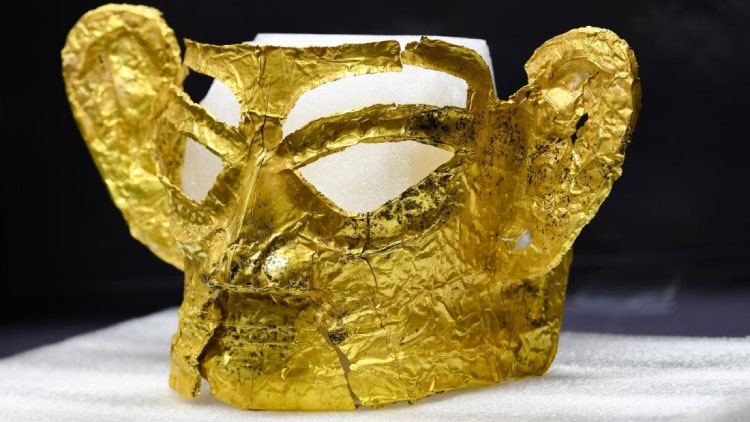Let’s take a look at some of the most incredible discoveries of 2021
Sat 11 Dec 2021
After a difficult year, it would certainly be nice to find a stash of gold coins worth more than $300,000 (AED 1m) in the walls of a house or a rare dish worth $1.7 million (AED 6M) tucked away in a drawer.
We’re often drawn to rare finds in unexpected places, as well as history-making archaeological digs that shed light on humanity’s past. This year, there was no mysterious monolith in the desert to keep us on the edge of our seats, but there were some incredible finds, as tiny as an insect trail in a famous artwork and as grand as an entire city.
Below are some of the most exciting art and design discoveries of 2021.
A surprise Rembrandt
When an artwork fell off the wall in a Roman country house in 2016, what started as a straightforward request to restore the piece set off an unexpected chain of events. It turned out to be a lost Rembrandt painting, once believed to have survived only through copies held at major institutions. This summer, the Italian Heritage Foundation confirmed “The Adoration of the Magi,” an oil on paper mounted on canvas, is an original made by the prolific Dutch master. Rembrandt painted the work in 1632-33, and it depicts the three wise men meeting the baby Jesus for the first time.
An ancient city is slowly uncovered
What was the biggest reveal of the year? An entire 3,000-year-old city — the largest discovered in Egypt — was unearthed from beneath the sand. Archaeologists began excavating “The Rise of Aten,” which was discovered on the western bank of Luxor, in the fall of 2020.
“The discovery of this lost city is the second most important archeological discovery since the tomb of Tutankhamun,” said Betsy Bryan, professor of Egyptology at Johns Hopkins University, in a statement.
As of April, archaeologists had uncovered much of the city’s southern half, finding intact houses with walls up to 10 feet (3 meters) high, a large bakery, and a burial site containing a skeleton. The rooms in the homes were filled with pottery vessels, tools for spinning, weaving, and glass-making, and jewelry still present, “left by the ancient residents as if it were yesterday,” according to the statement.
A warty pig gets its due
After a remarkable find in an Indonesian cave on the island of Sulawesi, a depiction of a warty pig is believed to be the oldest surviving image of an animal. At least 45,500 years old, archaeologists identified the warty pig in the artwork as such due to its hornlike protrusions; the red ocher-colored scene features three pigs altogether, with one possibly observing a fight between its two companions.
This discovery, as well as other recent finds from caves in the same region — including a hunting scene from 43,900 years ago depicting human-animal hybrids — have cemented Indonesia’s importance in early human history. For a long time, abstract symbols found in Europe were thought to be the oldest works of cave art.
“This discovery underlines the remarkable antiquity of Indonesia’s rock art and its great significance for understanding the deep-time history of art and its role in humanity’s early story,” Adam Brumm, a professor at Griffith’s Australian Research Centre for Human Evolution said.
A golden mask from a sacrificial pit
In June, a lightweight gold mask was one of around 500 relics recently excavated from a group of sacrificial pits in southwest China, at the archaeological site Sanxingdui located near Chengdu. Thousands of artifacts have been found at the 4.6-square-mile site since a local farmer accidentally located it a century ago. According to the state-run press agency Xinhua, the mask was likely part of a larger bronze head made during the late Shang dynasty, whose rule ended in 1046 BC. Among the other discoveries were ivory relics, bronze figurines, and a jade knife.
Tiny beads with historical implications
Blueberry-sized Venetian beads that were excavated in northern Alaska in the mid-2000s are now believed to be the earliest known European-made objects in North America, predating Christopher Columbus’s journey across the Atlantic. In January, the University of Alaska Fairbanks published a study with the researchers findings that the beads may have arrived between 1440 and 1480, decades before Columbus set sail in 1492. Some of the beads — along with some plant fibers that were carbon-dated to establish a time period — were unearthed at Punyik Point, a famous archaeological site that sits on an ancient trade route.
According to the university, Venice maintained trade routes to Asia during the 1400s, and the beads may have journeyed along the Silk Road toward China before making their way to Russia’s the Far East, then across the Bering Strait to the Arctic.
Source: Agencies

 Apr 25 2024
Apr 25 2024












